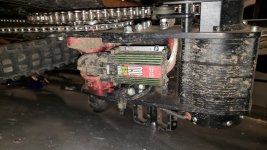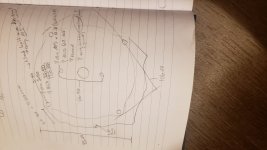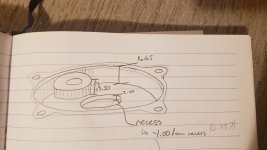My original tangent unit internals grenaded a couple years ago. I decided that since the reduction would be impossible to reverse engineer (even more difficult to source parts now) to the desired tolerances I would take a more conventional planetary-type reduction and mate it to the Astro. This is where the CYCX1 pro reduction came in. This would also mean that I'm using a conventional off the shelf part which should allow me to keep playing should I have any failures.
I had to design a housing to hold the astro, new BB mount plates, spider to hold the sprocket and chainring, and some other minor bits. So I got to work, took about a month of measuring, drawing and then finally designing it in CAD.
I had to have the shaft on the astro cut down shorter, turned and key slotted so that the CYC gear could fit on it. -had a local machinist/hobbyist do this for me.

For the CYC X1 planetary I wanted to keep things as compact as possible. It was necessary get proper tolerances for the sun gear on the astro shaft to mesh with the planetary gears in the reduction unit to mesh properly. My next concern was grease leakage from the mating surfaces of the Motor housing and the reduction, so I made a space for a spec'd large diameter oring which seals everything between them. I also incorporated a small port to add grease- although I think I will just split the unit anyways to clean and reapply instead.
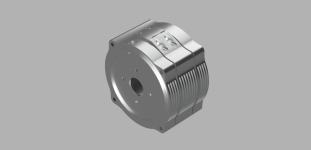
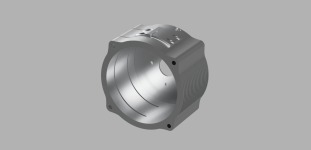
For the BB mount plates I wanted something that would allow me to quickly disassemble the motor from the bike if I ever want to use the bike for downhill hooliganism. My experience from a couple years ago is that they will not allow ebikes on the mountain. For this I made the mount a split unit.
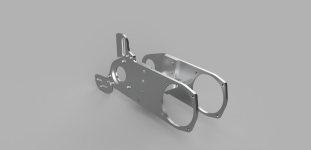
The spider was custom designed as well, and I'm quite proud of it for reasons I'll explain later. I kept the 219 sprocket and chain drive design from the CYC setup although I sourced my own quality kart chain from Panther(the only 219 chain that can be broken to custom lengths and properly riveted using their tools) and custom tooth count sprocket from RK. I used a HD wide crank freewheel from sickbikeparts.com. Now for the part I'm really proud of having worked out. I wanted to use a stainless steel chainring with narrow/wide profile... which meant that my options were limited. All my previous chainrings from the tangent unit were aluminum and they eventually failed due to the odd chain skip/drop here and there and softer material. Also for the particular final reduction I wanted at the crank and the rear wheel I was limited by the chainring BCD/freewheel diameter &BCD/Sprocket BCD. Days.... no weeks of prior internet searching for the proper BCD/tooth count/profile was a headache…. Finally I came across the Wolf Tooth components CAMO chainrings. These come in a 28 tooth count with narrow wide profile. The only problem was that WT decided to create their own standard for the BCD pattern… Which was a real PITA! They did not simply create a radially symmetric BCD pattern…Oh no… they decided to slightly offset all the Bolt holes(ever so slightly but not obviously) just to keep it proprietary I suppose. So I ordered a chainring and got to work reverse engineering. I cast the bolt holes in a rigid cold cure acrylic. Then I got to work with calipers triangulating all the bolt holes to references/each other etc. This is when I realize that the 5 hole BCD pattern was not symmetric. Then I drew this up in CAD. I was a bit hesitant to use this for the final STEP file for the CNC machining so I had the bright idea of 3D scanning the chainring at work using my intraoral dental scanner. It took quite a while to do since the scanner is designed for use in the mouth and the software recognizes tooth like structures as it scans, so I had to get creative with how to make the scanner work. Once I got a working STL of the chainring I imported the file and got to work measuring and creating a reference model for the BCD layout. Suffice it to say I could have probably used the original hand measured unit. Comparing the two I was only off by 0.07mm at the worst, below the tolerances needed for machining the unit. And the thus the spider born. This allows me to use the WT CAMO chainring mated to the 219 sprocket revolving on a crank mounted freewheel exactly as the offset I wanted.
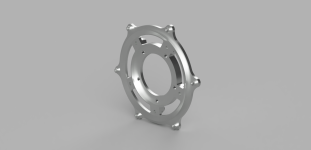
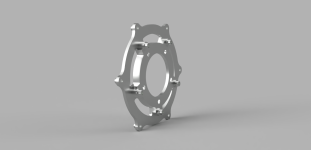
Producing the custom parts cost about $1000US
Everything works great apart from the upper and lower chain roller guides. There isn’t actually enough space for me to use the stock roller/guide. I will be designing some at some point.
The tensioner on the 219 kart chain uses the CYC kit parts apart from the spring tensioning. I found the spring tension to be too weak. So I drilled some extra holes and put a couple bolts through the side plate and used a door-bumper spring for tension; works great!
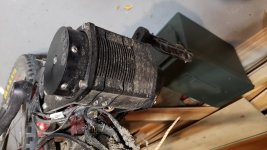
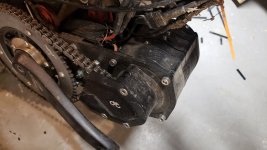
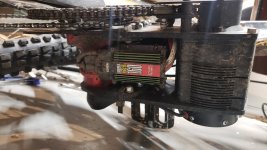
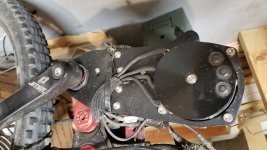
I had to design a housing to hold the astro, new BB mount plates, spider to hold the sprocket and chainring, and some other minor bits. So I got to work, took about a month of measuring, drawing and then finally designing it in CAD.
I had to have the shaft on the astro cut down shorter, turned and key slotted so that the CYC gear could fit on it. -had a local machinist/hobbyist do this for me.

For the CYC X1 planetary I wanted to keep things as compact as possible. It was necessary get proper tolerances for the sun gear on the astro shaft to mesh with the planetary gears in the reduction unit to mesh properly. My next concern was grease leakage from the mating surfaces of the Motor housing and the reduction, so I made a space for a spec'd large diameter oring which seals everything between them. I also incorporated a small port to add grease- although I think I will just split the unit anyways to clean and reapply instead.


For the BB mount plates I wanted something that would allow me to quickly disassemble the motor from the bike if I ever want to use the bike for downhill hooliganism. My experience from a couple years ago is that they will not allow ebikes on the mountain. For this I made the mount a split unit.

The spider was custom designed as well, and I'm quite proud of it for reasons I'll explain later. I kept the 219 sprocket and chain drive design from the CYC setup although I sourced my own quality kart chain from Panther(the only 219 chain that can be broken to custom lengths and properly riveted using their tools) and custom tooth count sprocket from RK. I used a HD wide crank freewheel from sickbikeparts.com. Now for the part I'm really proud of having worked out. I wanted to use a stainless steel chainring with narrow/wide profile... which meant that my options were limited. All my previous chainrings from the tangent unit were aluminum and they eventually failed due to the odd chain skip/drop here and there and softer material. Also for the particular final reduction I wanted at the crank and the rear wheel I was limited by the chainring BCD/freewheel diameter &BCD/Sprocket BCD. Days.... no weeks of prior internet searching for the proper BCD/tooth count/profile was a headache…. Finally I came across the Wolf Tooth components CAMO chainrings. These come in a 28 tooth count with narrow wide profile. The only problem was that WT decided to create their own standard for the BCD pattern… Which was a real PITA! They did not simply create a radially symmetric BCD pattern…Oh no… they decided to slightly offset all the Bolt holes(ever so slightly but not obviously) just to keep it proprietary I suppose. So I ordered a chainring and got to work reverse engineering. I cast the bolt holes in a rigid cold cure acrylic. Then I got to work with calipers triangulating all the bolt holes to references/each other etc. This is when I realize that the 5 hole BCD pattern was not symmetric. Then I drew this up in CAD. I was a bit hesitant to use this for the final STEP file for the CNC machining so I had the bright idea of 3D scanning the chainring at work using my intraoral dental scanner. It took quite a while to do since the scanner is designed for use in the mouth and the software recognizes tooth like structures as it scans, so I had to get creative with how to make the scanner work. Once I got a working STL of the chainring I imported the file and got to work measuring and creating a reference model for the BCD layout. Suffice it to say I could have probably used the original hand measured unit. Comparing the two I was only off by 0.07mm at the worst, below the tolerances needed for machining the unit. And the thus the spider born. This allows me to use the WT CAMO chainring mated to the 219 sprocket revolving on a crank mounted freewheel exactly as the offset I wanted.


Producing the custom parts cost about $1000US
Everything works great apart from the upper and lower chain roller guides. There isn’t actually enough space for me to use the stock roller/guide. I will be designing some at some point.
The tensioner on the 219 kart chain uses the CYC kit parts apart from the spring tensioning. I found the spring tension to be too weak. So I drilled some extra holes and put a couple bolts through the side plate and used a door-bumper spring for tension; works great!






